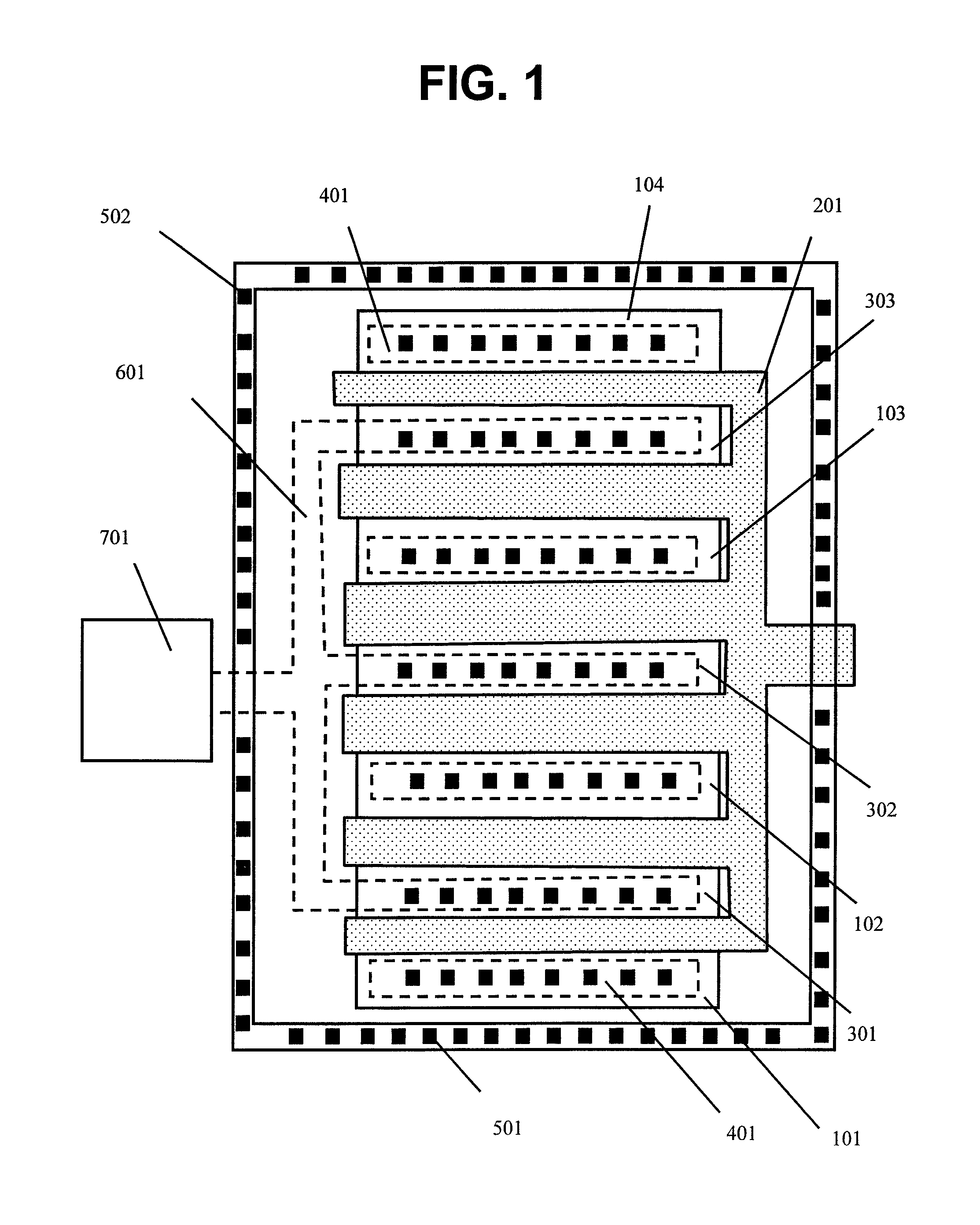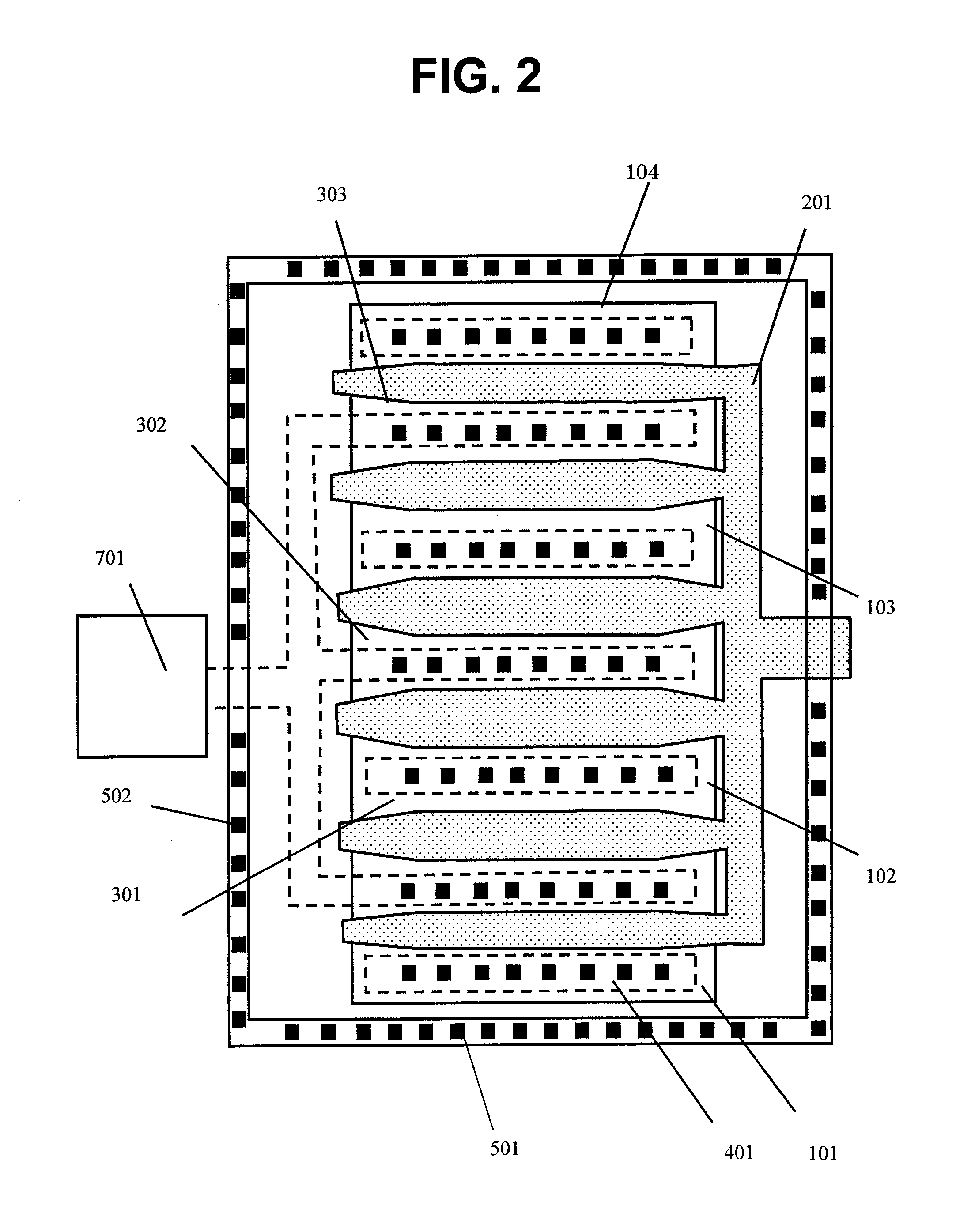Semiconductor device
a technology of semiconductors and devices, applied in the direction of semiconductor devices, electrical equipment, transistors, etc., can solve the problems of local breakdown, difficult to secure, local breakdown,
- Summary
- Abstract
- Description
- Claims
- Application Information
AI Technical Summary
Benefits of technology
Problems solved by technology
Method used
Image
Examples
first embodiment
[0017]FIG. 1 is a schematic plan view illustrating an N-type MOS transistor for ESD protection of a semiconductor device according to a first embodiment of the present invention.
[0018]A first source region 101 and a first drain region 301, which are N-type high concentration impurity regions, are formed. A gate insulating film, which is a silicon oxide film or the like, is provided between the first source region 101 and the first drain region 301. A gate electrode 201 formed of polysilicon or the like is formed on an upper surface of the gate insulating film. A second source region 102 is formed next to the first drain region 301 with the gate electrode 201 interposed therebetween. A second drain region 302 is formed next to the second source region 102 with the gate electrode 201 interposed therebetween. In a pattern in which the above is repeated similarly, a third source region 103, a third drain region 303, and a fourth source region 104 are formed with the electrode 201 interp...
second embodiment
[0021]FIG. 2 is a schematic plan view illustrating an N-type MOS transistor for ESD protection of a semiconductor device according to a second embodiment of the present invention. Like reference numerals are used to designate members corresponding to those illustrated in FIG. 1. The second embodiment is different from the first embodiment illustrated in FIG. 1 in that the length L of the unit gate electrode is not fixed. In FIG. 2, not only the substrate contacts 501 arranged in the direction in parallel with the channel width which is the lateral direction in the figure but also the substrate contacts 502 arranged in the direction in parallel with the channel length which is a longitudinal direction in the figure are provided. In consideration of this, the lengths L around distal ends and proximal ends at which the distance to the substrate contact 502 is small of the comb teeth of the gate electrode 201 are set smaller than the lengths L around intermediate portions, respectively....
third embodiment
[0023]FIG. 3 is a schematic plan view illustrating an N-type MOS transistor for ESD protection of a semiconductor device according to a third embodiment of the present invention. Like reference numerals are used to designate members corresponding to those illustrated in FIG. 1. The third embodiment is different from the first embodiment illustrated in FIG. 1 in that, by omitting the substrate contacts arranged in the direction in parallel with the channel length of the N-type MOS transistor for ESD protection, the influence of difference in substrate potential in the direction in parallel with the channel length is eliminated, and only the substrate contacts 501 arranged in the direction in parallel with the channel width are provided on the guard ring around the outer periphery. The comb teeth of the gate electrode 201 in this case are provided so that, similarly to the case of the first embodiment, the length L of the comb tooth of the gate electrode is reduced as the distance fro...
PUM
 Login to View More
Login to View More Abstract
Description
Claims
Application Information
 Login to View More
Login to View More - R&D
- Intellectual Property
- Life Sciences
- Materials
- Tech Scout
- Unparalleled Data Quality
- Higher Quality Content
- 60% Fewer Hallucinations
Browse by: Latest US Patents, China's latest patents, Technical Efficacy Thesaurus, Application Domain, Technology Topic, Popular Technical Reports.
© 2025 PatSnap. All rights reserved.Legal|Privacy policy|Modern Slavery Act Transparency Statement|Sitemap|About US| Contact US: help@patsnap.com



